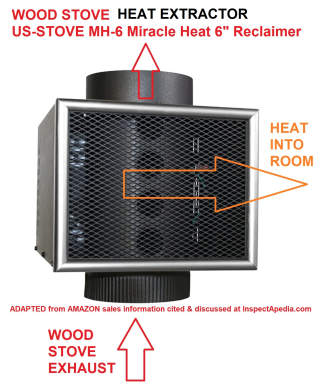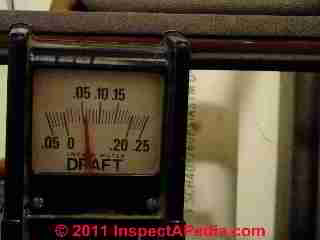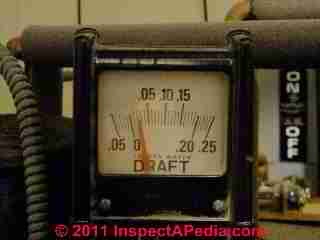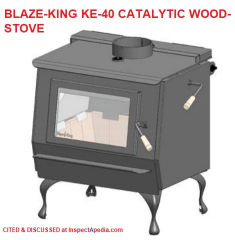 Catalytic Combustor Wood Stoves
Catalytic Combustor Wood Stoves
Draft Adjustment & Catalytic Wood Stove Puff-back Repair
- POST a QUESTION or COMMENT about installing, adjusting & troubleshooting catalytic combustor woodstoves
How to install, adjust & troubleshoot catalytic combustor woodstoves.
A wood-stove catalytic combustor improves the burning efficiency of a wood-burning stove to extract more heat from the firewood and at the same time to produce a significantly cleaner exhaust than that found in the normal smoke produced by burning firewood.
This article series explains the methods of measurement and proper adjustment settings for heating equipment.
InspectAPedia tolerates no conflicts of interest. We have no relationship with advertisers, products, or services discussed at this website.
- Daniel Friedman, Publisher/Editor/Author - See WHO ARE WE?
Wood Stove Catalytic Combustors
How does a Woodstove Catalytic Combustor Work?
The operating concept of a wood stove combustor is the same as that familiar to readers whose automobile uses a catalytic converter to clean up their vehicle's exhaust. Catalysis is defined as the speeding-up of a chemical reaction by using a catalyst - an additive or agent whose presence speeds up a chemical reaction.
In a woodstove catalytic combustor, smoke and hot gases from burning firewood pass through a honeycomb of material coated with platinum/palladium that, at sufficient temperature, break down the components of the smoke into less harmful end products, ideally, or in perfect operation, producing simply carbon dioxide (CO2) and water (H2O).
[Click to enlarge any image]
The platinum or palladium (both may be present) are the catalysts. The honeycomb design provides sufficient surface area to treat the volume of exhaust passing through the combustor. High temperature is necessary for the catalytic process to occur.
The temperature rage at which a catalytic combustor in a woodstove can work varies among specific catalytic combustor products and among wood stoves, but typically the device can operate as low as 250°F (121°C)in some designs, but more often at a higher temperature, between 400°F (240°C) and 500°F (260°C).
To protect the combustor from damage or clogging with creosote and ash, the woodstove will include either a manual or an automatic control to bypass the catalytic device when the stove is not at sufficient operating temperature.
Shown above, the Midwest Hearth wood stove catalytic combustor, as promoted on Amazon - retrieved 2021/12/09 original source: https://www.amazon.com/Midwest-Hearth-Catalytic-Combustor-Replacement [we were not able to find an online installation manual for this woodstove catalytic combustor - but below we provide contact information for the company - Ed.] This woodstove catalytic combustor replacement component sold for about $150. U.S. (Amazon December 2021). Midwest Hearth 3360 Quail Road NE Sauk Rapids, MN 56379 USA Web: https://midwesthearth.com/ Tel: 320-433-0008
Some wood stoves such as Vermont Castings' Intrepid II, also include a permanently-mounted temperature probe that indicates the proper operating temperature range for the stove in order that the catalytic combustor will work properly.
The catalytic combustor is typically located inside a special chamber in the wood burning stove where, protected from direct flame of the burning fire, the firewood's smoke and exhaust gases enter the chamber, mix with secondary air to complete combustion, and pass through the catalytic combustor where additional combustion occurs, finally entering the the stove's exhaust flue connector on the way to the building chimney.
Cost Benefits of Woodstove Catalytic Combustors
A true catalytic combustor used in some woodstoves reduces creosote build-up in chimneys, thereby reducing the risk of a creosote fire in the flue.
A woodstove catalytic combustor also will get more heat out of your firewood, reducing your firewood cost as well as venting less wood-smoke contaminants to the environment around your building.
Manufacturers including Midwest Hearth shown here assert that using a catalytic combustor in a wood-stove will cut the stove's air pollution by 70%, reduce the risk of a creosote chimney fire by 75%, and reduce your firewood consumption by about 30%. - cited below.
Watch out: be sure to read the installation, use, and cleaning instructions for your woodstove and for its catalytic combustor. Some creosote removing products will damage the catalytic combustor unless the stove is run in bypass mode, while others are safe to use.
Most sources give about a ten-year life for a catalytic combustor element used in woodstoves. Considering that the device costs less than $200. you should earn back much more than that in the cost of firewood burned, additional heat obtained, and probably in reduced chimney cleaning cost as well.
Is it a Wood Stove Catalytic Combustor or a Wood Stove Heat Extractor?
Below, a different device, a wood-stove heat extractor also sends more heat from a wood burning stove into the occupied space around the stove, but this is not a catalytic combustor, even though a web search for "woodstove catalytic combustor" will include this in the search return.
This is a heat extractor that is placed in line in the wood-stove's exhaust flue vent connector between the stove and the chimney. Air passing through this heat exchanging device cools the woodstove exhaust and vents that reclaimed heat into the room
Watch out: both of these devices require careful following of the specific manufacturer's instructions for both successful function and for wood stove safety.
See this
- MIRACLE HEAT DELUXE INSTALLATION INSTRUCTIONS [PDF] Models MHD-6 & MHD-8, United States Stove Company 227 Industrial Park Rd. South Pittsburgh, TN 37380, USA Phone: (800)750-2723 www.usstove.com , retrieved 2021/12/09 original source: https://www.usstove.com/wp-content/uploads/sites/2/2020/08/MH6-MH8-Owners-Manual.pdf
Draft Management to Avoid Overheating & Puffing & Woodstove Puff-Backs at Catalytic Wood-Stoves
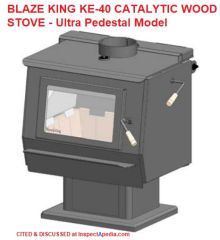 Reader Question: What should the draft be on my catalytic wood stove?
Reader Question: What should the draft be on my catalytic wood stove?
(2021-12-06) JR said:
During a "Back Puffing" event what would the draft measurement be above the flue collar?
And let me also ask, is it unreasonable to expect a catalytic wood stove to work properly with a draft at the collar between .04 and .08 inches of H2O ?
Properly meaning no fumes being pushed out during operation.
Illustration, one of three models of the Blaze-King KE40 catalytic combustor woodstove cited in more detail below.
[Click to enlarge any image]
Reply by Inspectapedia Com Moderator - puff-backs or back-puffing woodstove using a catalytic combustor
@JR,
Short answer: check with what your manufacturer says, or start wit 0.05" of water column. You also want to check the operating temperature of your stove and you want to assure that the catalytic combustor remains bypassed until the stove is at proper operating temperature.
In your initial question you asked about draft associated with a "puffback" and we thought you were referring to the explosive force that we describe below, associated with a malfunctioning oil burner.
But from the ensuing discussion it looks as if we're actually discussing a type of "puffing" or "puff-back" that occurs specifically in catalytic-type wood stoves - wood burning stoves that use a catalytic combustor to extract more heat out of the burned-wood than a conventional wood stove.
So we’ve organized our discussion and advice under this topic:
Catalytic Wood Stove Puffbacks: Draft Control to Avoid Overheating & Puffing or Puff-Backs
What's the difference between a smoke-puffing woodstove and an oil-burner puffback?
Definition of an Oil Burner Puffback
An oil burner puffback explosion is a sudden, brief explosion: the ignition of collected un-burned fuel in an oil burner heated device like a water heater, furnace, or boiler.
During that brief interval (seconds) there will be extreme back pressure in the combustion chamber. It seems certain that at that moment there will be no negative draft in the chimney but rather an extremely positive one in the chimney - as the forces of the puffback explosion not only blow soot out all over the building (typically a lot of soot exits at the barometric damper and more at other boiler or furnace openings such as combustion air inlets).
That oil burner event is different than “puffing” or “puff-back” for catalytic woodstoves, although it is clearly an easily confused distinction.
For readers concerned with oil burner puffbacks, please see this separate article:
Back-puffing or puffs of smoke exiting a woodstove using a catalytic combustor is different from an oil burner puffback.
Definition of Wood-Stove Back-Puffing
Back-puffing at a woodstove occurs when the wood stove draft is inadequate: the draft is insufficient to remove volatile or combustible gases from the wood stove fire-box fast enough.
The result is that highly-volatile gases accumulate inside the wood-stove's fire chamber where they accumulate in quantity and increase in temperature until the gases ignite, causing a burst of pressure or "puff" of burned gases inside the stove.
The result of that sudden extra pressure can be an audible "puff" sound followed by a burst or leak of smoke into the room through small openings in the wood stove, including from its combustion air intake openings.
What to do immediately if your woodstove is back-puffing
- Open the woodstove flue damper to increase the draft to let the woodstove's exhaust or smoke vent up the chimney more quickly
- Open the woodstove's combustion air to allow increased combustion air into the fire chamber so that un-burned gases don't accumulate.
- Check the condition of your firewood. Very-dry firewood may be burning hotter and faster than you anticipated, producing gases faster than the woodstove can burn-them.
If your firewood is quite dry and burns quickly and hot, take care not to over-load the firebox with too much wood: build smaller fires. - Test your woodstove draft for adequacy. We describe this procedure
at WOOD STOVE DRAFT TEST
and just below we describe in more-detail the diagnosis and cure of catalytic woodstove back-puffing.
Set Catalytic Wood Stove Draft Level to Avoid Puffing
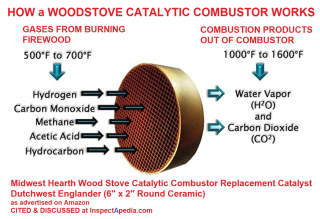 Illustration: adapted from Midwest Hearth Wood Stove Catalytic Combustor Replacement Catalyst: Dutchwsest Englander, advertisement and product description provided at Amazon.com 2021/12/09. This is a 6" diameter x 2" thick catalytic combustor.
Illustration: adapted from Midwest Hearth Wood Stove Catalytic Combustor Replacement Catalyst: Dutchwsest Englander, advertisement and product description provided at Amazon.com 2021/12/09. This is a 6" diameter x 2" thick catalytic combustor.
It's significant that the "experts" over at the US EPA, writing on the critical safety of proper draft at a wood stove, catalytic type, mention "draft" 10 times in their write up without ever giving a wood stove draft number.
Why?
I suspect that they, like I do, think the proper draft for safe operation of a catalytic woodstove is likely to depend on both the specific wood stove brand and model but also on the site and venting system or chimney type, height, etc.
See
- CATALYTIC WOODSTOVE INSTALLATION - [PDF] U.S. EPA, Environmental Protection Agency - retrieved 2021/12/05 original source: https://www.epa.gov/sites/default/files/2013-09/documents/catalytic.pdf
Too much draft in a catalytic combustor wood stove causes overheating and damage and is unsafe.
Too little draft in a catalytic combustor wood stove causes smoke backup and possibly wood stove "puffing" and clogging soot formation.
Watch out: some catalytic combustor woodstove companies and discussions warn that improper draft in those heaters can damage the equipment or be unsafe. For example, too much draft can draw flames into the interior of the catalytic combustor, damaging it.
Proper draft is achieved by a combination of features including flue size, shape, routing, height, chimney cap, terrain features nearby, wind directions, and more.
Draft vs. Temperature: So what's the right draft by measurement?
In our research so far, the manufacturer doesn't expect you to measure catalytic wood stove draft; rather they think you'll monitor its temperature.
Ideal temperature appears to be no higher than 1000°F and no less than 250°F and for some models the minimum temperature may need to be 400°F or 500°F.
Watch out: 1800°F is dangerous enough that the stove should shut down. (Measured at the catalytic combustor?)
But if you are measuring catalytic wood stove draft:
Don't allow the draft to exceed .06" of water draft (or a different number like 0.05" water column draft if specified by the maker of your specific stove).
Check the installation and operating instructions for your specific catalytic wood stove manufacturer and brand.
Also see
- PRINCESS CATALYTIC WOOD STOVE INSTRUCTIONS [PDF] BlazeKing, Valley Comfort Systems Inc., 1290 Commercial Way, Penticton, BC, V2A 3H5, Canada
Tel: 250-493-7444 Web: www.blazeking.com Email: info@blazeking.com
Note: this document discusses draft adjustment for woodstoves using a catalytic combustor, but gives NO draft measurement numbers. - retrieved 2021/12/05 - CATALYTIC WOOD STOVE OPERATION [PDF] (2014) prepared for Urban Hearth, 6154 Highway 43 Perth, Ontario K7H 3C7 Canada, Tel: 1-866-377-1796, a distributor of Jotul, BlazeKing, STUV, KozyHeat and other heating and BBQ appliances, website: https://urbanhearth.ca/ by Gulland Associates, - retrieved 2021/12/05 original source: https://urbanhearth.ca/handouts-new/45-how-to-operate-your-catalytic-stove/file
As an example of empirical observations that address proper catalytic woodstove draft, we have:
How do you know if your draft is excessively high or low?
Symptoms of too much draft include an uncontrollable burn or a glowing-red stove part.
A sign of inadequate draft is smoke leaking into the room through the stove or chimney connector joints, low heat, and dirty glass.
Draft Testing:
An easy way to test your chimney draft is to close the stove’s damper, wait a few minutes to let the airflow stabilize, then see whether you can vary the strength of the fire by swinging the air control open and closed.
Results are not always instant; you may need to wait a few minutes for a change in the air control setting to have an effect on the fire.
If there’s no change, then the draft isn’t strong enough yet to let you close the damper, and you’ll need to open it for a while longer and manage the fire with the air inlet until the draft strengthens.
If you keep track of your burning habits and relate them to their effects on the stove’s operation, you’ll be rewarded with good performance and a safe system. - source: Vermont Castings cited just below.
- INTREPID WOOD STOVE CATALYTIC COMBUSTER INSTRUCTIONS [PDF] (2019) Vermont Castings Stove Co., 352 Mountain House Road , Halifax, PA 17032
USA, Website: www.vermontcastings.com - retrieved 2021/12/05
Excerpt:
Temperature Probe:
Your stove is equipped with a temperature probe which shows the operating range of the catalytic combustor. This is located on the back of the stove and is viewed from the top. If the probe indicator is below the operate catalyst range, add fuel or open the bypass damper too allow the fire to build.
Closing the bypass damper should then result in an increase in catalyst temperature to within the operate catalyst range. If the probe indicator is above the operate catalyst range, the catalytic combustor is running to hot and may be damaged. In many cases, increasing the primary air can reduce the catalyst temperature and adding less wood with each loading can also help if overheating is persistent.
Overly dry wood can also cause overheating of the catalyst element. Do not add wood to the stove if the probe reads above the operate catalyst range.
This article has extensive and detailed (but not quantitative) advice on draft management for catalytic type wood stoves.
One more reference,
- IDEAL STEEL HYBRID WOODSTOVE MANUAL [PDF] (2020) Gear Head Stoves, Woodstock Soapstone Company, Inc. 66 Airpark Road, West Lebanon, NH 03784 USA Tel: 1-800-866-4344 Website: www.woodstove.com
provides more examples of catalytic type wood stove operating draft settings without using any quantitative data.
Bottom line on Catalytic Wood Stove Draft Level Numbers
Image above shows a draft gauge indicating -0.06" W.C. (water column). The few citations we found gave a measured draft for a catalytic type woodstove as operating at -0.05" of water column negative draft measured in the chimney above the stove.
All of the sources list other ways to know if draft is too weak or too strong.
To work effectively, the chimney that serves your wood stove, catalytic type, should have a draft capacity of no less than -0.05" Water Column and should be able to produce drafts up to -0.08" WC just as our reader, JR, suggested, because site conditions, weather conditions and other variables will at times require you to call on the chimney for more draft simply to achieve the target 0.05" measured over the stove itself.
That is to say, you may want to set the draft at -0.05" but to be reliable the chimney needs to be capable of more draft, up to around -0.08" -
read more about that need
at CHIMNEY RESERVE DRAFT MEASUREMENT
Watch out: if you are actually measuring draft on your catalytic wood stove and it is showing a very weak draft of -0.02", your draft is probably inadequate and won't draft properly, as shown in our photo below.
Continuing comment from JR:
 Thank you for the reference materials, and as you mentioned the stove manufacturers do not commit to actual numbers for draft requirements, for some reason I expect .
Thank you for the reference materials, and as you mentioned the stove manufacturers do not commit to actual numbers for draft requirements, for some reason I expect .
I am struggling with fumes exiting my new Blaze King KE40 catalytic wood stove, not smoke but off gas, from the smoldering process (gasification), being forced out through the door gasket.
I honestly believe these new CAT stoves are of bad design and can allow toxic gases to exit into the home environment without notice, a serious danger to the health of users in my opinion and should be investigated by the appropriate agencies.
Reply by Inspectapedia Com Moderator
Thank you for the added comment, it will be important for other readers who use catalytic woodstoves.
We're not experts on that specific woodstove feature but in reading through a number of catalytic wood stove installation manuals we found it apparent that a lot of ink is given to proper draft management, and it's a common warning that inadequate draft is likely to produce puffing or back-puffing huffing from a catalytic wood stove.
I think the manufacturers will argue that if we follow their instructions the stove will work well. I've seen comments from people who were happy with their catalytic woodstove and others discussing damaged catalytic heat extractors - again blamed on failure to follow all of the manufacturer's instructions.
We'll continue to research this question.
My OPINION to date is that good design of any building system or feature should design for what people are likely to do, not what you want them to do.
For readers who need a copy, here is the
- BLAZE-KING KE40 CATALYTIC WOOD STOVE MANUAL [PDF] (2021) - Blaze King, Valley Comfort Systems Inc., cited above, op. cit.., - retrieved 2021/12/05, original source: https://www.blazeking.com/wp-content/uploads/2021/07/180-KE40-july2021.pdf
Here are two excerpts from your stove manual:
DRAFTING PERFORMANCE
Draft is the force which moves air into the appliance up through the chimney. The amount of draft created by
your chimney depends upon length, offsets, insulating properties, obstructions (such as architectural design,
trees), local geography and other factors.
External forces, such as outdoor temperature, wind, barometric pressure, topography, or factors inside the
home (negative pressure from exhaust fans, chimneys, air infiltration, etc) may adversely affect draft.
Too much draft may cause excessive temperatures in the appliance and may damage the heater. An
uncontrollable burn or excessive temperature indicates excessive draft.
Inadequate draft may cause back puffing (spillage) into the room and plugging of the chimney, chimney cap or
spark arrestor screen. Inadequate draft may cause smoke to leak into the room through appliance or chimney
connector joints.
Poor draft can also lead to poor heat production and the inability for the combustor to remain
active in lower burn rate settings.
High efficiency appliances, such as your Blaze King stove, may require some fine tuning of your chimney
system in order to maximize performance.
Blaze King cannot be responsible for external forces leading to less than optimal performance.
and
ROLE OF THE CHIMNEY
Without a proper installed chimney, this appliance will not burn correctly.
The role of the chimney is to pull the proper amount of air into the firebox for the purpose of complete
combustion. Incomplete combustion will lead to more smoke and pollution of the outside air. A proper
operating chimney will allow the user to enjoy peak performance at all burn operating levels from low to high
Watch out: because life-safety concerns apply when measuring or adjusting the draft on fossil-fuel appliances and because different fuels and heater types use different settings and even measurement procedures, be sure to see the specific draft measurement articles cited in the sections of the article above
...
Continue reading at CHIMNEY RESERVE DRAFT MEASUREMENT or select a topic from the closely-related articles below, or see the complete ARTICLE INDEX.
Or see these
Recommended Articles
- CHIMNEY DRAFT & PERFORMANCE
- CHIMNEY HEIGHT & CLEARANCE CODE required height of a chimney above the building roof.
- CHIMNEY INSPECTION DIAGNOSIS REPAIR - home
- CHIMNEY RESERVE DRAFT MEASUREMENT
- CREOSOTE FIRE HAZARDS
- DAMPERS & DRAFT REGULATOR TYPES
- DRAFT MEASUREMENT, CHIMNEYS & FLUES
- FIREPLACE & WOODSTOVE CONTAMINANTS
- WOOD STOVE OPERATION & SAFETY - home
- COMBUSTION AIR for WOODSTOVES
- DEFECTS LIST - HEAT, WOOD APPLIANCE
- FIRE CLEARANCES, WOOD COAL & PELLET STOVES
- FIREPLACE INSERTS INSTALL, INSPECT, REPAIR
- HEAT SHIELD SPECIFICATIONS for WOOD STOVES & PELLET STOVES
- PELLET STOVE CLEARANCE DISTANCES
- PELLET STOVE DRAFT CONTROL
- PELLET STOVE MANUALS
- WOOD FURNACE FAN LIMIT CONTROL
- WOODSTOVE DRAFT CONTROL
- WOOD STOVE DRAFT TEST
- WOOD STOVE, CATALYTIC PUFF-BACKS
- WOOD STOVE INSTALL CONVERT
- WOOD STOVE INSPECTION CHECKLIST [PDF]
- WOOD STOVE MANUALS
- WATER PRESSURE per FOOT of HEIGHT
Suggested citation for this web page
WOOD STOVE, CATALYTIC PUFF-BACKS at InspectApedia.com - online encyclopedia of building & environmental inspection, testing, diagnosis, repair, & problem prevention advice.
Or see
INDEX to RELATED ARTICLES: ARTICLE INDEX to CHIMNEYS & FLUES
Or use the SEARCH BOX found below to Ask a Question or Search InspectApedia
Ask a Question or Search InspectApedia
Try the search box just below, or if you prefer, post a question or comment in the Comments box below and we will respond promptly.
Search the InspectApedia website
Note: appearance of your Comment below may be delayed: if your comment contains an image, photograph, web link, or text that looks to the software as if it might be a web link, your posting will appear after it has been approved by a moderator. Apologies for the delay.
Only one image can be added per comment but you can post as many comments, and therefore images, as you like.
You will not receive a notification when a response to your question has been posted.
Please bookmark this page to make it easy for you to check back for our response.
IF above you see "Comment Form is loading comments..." then COMMENT BOX - countable.ca / bawkbox.com IS NOT WORKING.
In any case you are welcome to send an email directly to us at InspectApedia.com at editor@inspectApedia.com
We'll reply to you directly. Please help us help you by noting, in your email, the URL of the InspectApedia page where you wanted to comment.
Citations & References
In addition to any citations in the article above, a full list is available on request.
- In addition to citations & references found in this article, see the research citations given at the end of the related articles found at our suggested
CONTINUE READING or RECOMMENDED ARTICLES.
- Carson, Dunlop & Associates Ltd., 120 Carlton Street Suite 407, Toronto ON M5A 4K2. Tel: (416) 964-9415 1-800-268-7070 Email: info@carsondunlop.com. Alan Carson is a past president of ASHI, the American Society of Home Inspectors.
Thanks to Alan Carson and Bob Dunlop, for permission for InspectAPedia to use text excerpts from The HOME REFERENCE BOOK - the Encyclopedia of Homes and to use illustrations from The ILLUSTRATED HOME .
Carson Dunlop Associates provides extensive home inspection education and report writing material. In gratitude we provide links to tsome Carson Dunlop Associates products and services.


